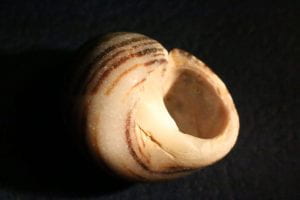These past two sessions have focused on preparing me for my three photo collections. Here’s my progress report:
Monday, February 1:
During this session, my mentor and I focused on experimenting with the impact that different colours of light had on the quality and mood of images. We did this by taking several different photographs of a shell, each under a different color of light. Here are the photos:
Something else my mentor taught me about the relationship between colour and photographs was the concept of dominant and receding colors. In photography, the dominant colors are the warm colors, e.g. red, yellow, and orange. These colors are considered dominant because they reach our eyes before the cooler colors. The cooler colors are the receding colors, e.g. blue, green and purple.
The warm colors are dominant because they demand your attention first, leaving the receding colors to fade into the background more.
Saturday, February 6:
After the session where we experimented with colour, my mentor left me alone to take photos over the next week for us to look at during the next session. Here is a list of everything that I learned while taking photos on my own over the week:
- The photos that worked all had good composition (the way that objects are placed in a photograph)
- A lot of my photos captured household objects indoors at dusk, so I had to rely on artificial light. This was harder to work with than natural light. Therefore, photography works better in daylight
- For portraits/close-up pictures of faces, make sure the camera’s focus is on the subject’s eyes since this will convey the emotion and tell the best story.
- In general, focus on what’s most important, and don’t be afraid to let the background blur out.
Here are a few of the photos I took:
How to Have a Beautiful Mind Questions:
- How to be interesting:
After learning how to compensate for any conflict that might occur during our mentorship, for this post, we will focus on maintaining engaging conversations. The key way to be interesting is to be humble. While one’s accomplishments or cleverness might be somewhat interesting, consistently bragging about everything you’ve done is not. To keep both parties in a conversation engaged and interested, the entire conversation should not be self-centered. There are many ways in which one can make a conversation more interesting, a good example being the sharing of interesting facts or funny stories. But if one doesn’t have heaps of facts or stories memorized, one of the best ways of keeping interest in a conversation would be to use “what if” statements.
Incorporating “what if” statements into a conversation is a surefire way to explore possible ideas, and to see if those ideas are possible. The session where my mentor and I explored photography under different wavelengths of light started with a “what if” statement. In our case, the “what if” statement was “what if we used different colours of light to take the same photo?” This ended up opening an excellent conversation surrounding how different light conveys different moods and also manipulates the camera’s ability to focus in different ways.
Another aspect of being interesting is exploring, elaborating, and pulling interest out of the subject. If one finds something that is being discussed to be interesting, they should try to explore the topic further, elaborate on the reasons for which they find the topic interesting, and try to pull more interest out of the topic. In my case, when my mentor and I discussed the different themes I wanted to use for my collections, I had to talk about the specific subjects I wanted to photograph (things in the forest, nature in urban areas, etc), as well as why I might find them interesting (mood, passion for nature, the stories that could be conveyed through different camera angles). This brainstorm is helping me with the design process for my photo collections.
Finally, to be more interesting, find and make connections that link matters together and generate interest. When connections are made between two separate interesting topics, then there is room to learn more about the topic and delve deeper into understanding and learning. When my mentor and I investigated the use of different colours of light in photographs, we were able to draw a connection between colours and moods (blue light = lower, calm, sad).
- How to respond:
In delving deeper into the aspects of a successful conversation, one must first know how to reply or respond to information that’s being put out. There are many different ways that one could respond in a conversation, but the aspects that I’ll be focusing on today include clarification, support, sharing, and modifying.
One of the main goals for TALONS this year is to improve our communication. While there are many aspects to good communication, one of such is clarification. To be able to understand what is being communicated to you, you must always clarify your understanding before allowing for the conversation to continue. So far, I’ve never been too confused with any of my mentor’s advice or teachings at any point, but if I didn’t understand something right away, I might double-check my understanding with him.
Support includes not only agreeing with the person you’re talking to but also putting forth an opinion that strengthens the other person’s claim, proposition, or stance. How to Have a Beautiful Mind goes into more depth. “You may support a proposition from your own experience…you may support a proposition from your feelings or emotions…you may support a proposition from a shared set of values or moral principles…you may offer support from facts, figures, and statistics which you happen to know…you may offer stories, examples, anecdotes all of which support the proposition that’s been put forward.” [pg 56]. When I was talking to my mentor about the various themes for my three collections, he mentioned how he liked taking photos in nature, and I said “I agree with you since I find that there’s a lot more to capture while in nature.‘
In the “support” section of this post, I mentioned that the book said one way in which one could agree could be through stories, examples, or anecdotes, and this section will delve deeper into that. Stories, unlike statistics, cannot disprove a statement, but they can slightly alter a statement. The book gives an example that “the generalization that ‘all teenagers are lazy’ can be reduced to ‘some teenagers are lazy’” through an anecdote [pg 58]. To put it more simply, stories “[do not] prove anything but [illustrate] a possibility.” [pg 58] So far, I haven’t really told my mentor any stories/anecdotes in response to his opinions, but it is a useful strategy that I might implement in the future.
Finally, someone who doesn’t completely agree with a statement being put forth does have the option to modify that statement. This can include reducing a sweeping generalization into a less absolute statement. Again, I haven’t been in a situation where I’ve had to use this particular strategy, but a scenario in which I might be able to would be if my mentor suggested that make all of my photos black and white since it would create moodier photos. My modification would be suggesting to play with different lighting to make the photos moodier or to experiment with making one of the three collections in black and white.








